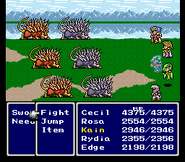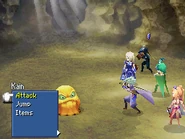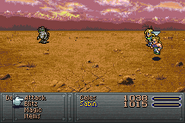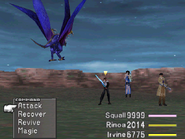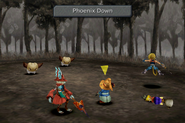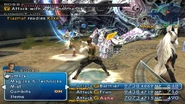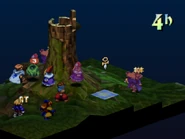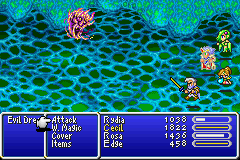
Float as seen in Final Fantasy IV.
Float (レビテト, Rebiteto?, lit. Levitate) is a recurring status effect in the Final Fantasy series. Floating units are immune to Earth-based attacks and damage floors in the early games in the series, but can become weak to Wind attacks. Float is usually bestowed by the spell of the same name.
Appearances[]
Final Fantasy IV[]

Characters with Float are unhurt by damage floors. The status wears off when the player changes areas and must be recast in the new area, or after battle on the world map. Floating units avoid all damage from Quake spells.
It is exceptionally useful when the party visits the Feymarch and the Sylph Cave. In the 3D versions, having Float cast on characters a second time removes the status.
In the SNES version, Float disables Yang's Kick command.
Final Fantasy IV -Interlude-[]
The Float status returns as a status effect, and it functions the same way as its predecessor.
Final Fantasy IV: The After Years[]
Float functions the same as in the previous games.
Final Fantasy V[]

Float protects the party from hazards on the map and earth damage. It is bestowed with the Time Mage's Float spell. The Mix item Levisalve (Levitate in the PS version) casts float on the entire party, and can be mixed from a Phoenix Down and Holy Water. The Blue Magic spell Mighty Guard also casts Float. Zombified party members cannot float.
Final Fantasy VI[]

Characters with the float status will be protected from earth-elemental attacks, which will miss automatically, but their vulnerability to Locke's Hawkeye and Sniper weapons will be increased. Flying enemies normally have this status permanently set. The player can bestow float with Float spell and Angel Wings relic, though the latter has a hazardous bug associated with it: removing the Angel Wings also permanently removes Interceptor status from the character.
Final Fantasy VIII[]

Float protects against ground-based attacks and magic. When Minotaur and Sacred are affected by Float, their HP-regaining abilities are lost. Float status can be granted through Float spell and Quistis's Mighty guard, and can be used by the enemy Gesper.
Final Fantasy IX[]

Float is a status that makes ground-based attacks miss. Float does not make one weak to Wind, even if some enemies that use Wind attacks also use Float on the player's party. The status lapses unless applied from Auto-Float.
Final Fantasy XII[]

Float allows the party to avoid traps, as party members will float right over them. Additionally, Float causes Hashmal's Quakeja and Roxxor to always miss, and makes moving on the field silent as the characters will not have audible foot steps. Winged Boots grant Auto-Float to its user, and the item Float Mote also causes the Float status. The status is bestowed by the Float spell Time Magick.
Final Fantasy Tactics[]
Float is a status granted by the Time Magick spell of the same name, the accessories Winged Boots and Cherche, and the movement ability Levitate.
Floating units are suspended 1H above where they are standing and Earth-elemental attacks will not affect them. Floating characters can move over rugged terrain without penalty, such as lava and water, and are unaffected by other terrain-based penalties, such as the inability to move in water of depth 2h or greater (a character with Float will float 1h above the water level). Characters with the Levitate movement ability (but not those who received the status from the boots, the Cherche, or from the Time Magick) can stop over lava.
Final Fantasy Explorers[]
Float prevents damage from terrain (poison water, lava, etc).
Non-Final Fantasy appearances[]
Rudora no Hihō[]

The Float status protects against Earth and Void attacks. The status can only be granted by specific Wind damaging mantras. If the player wants the Float status on their party members, they have to cast a damaging Wind mantra on them.
Gallery[]
Etymology[]
The Japanese name is levitate. Levitation (from Latin levitas "lightness") is the process by which an object is held aloft, without mechanical support, in a stable position. Levitation is accomplished by providing an upward force that counteracts the pull of gravity (in relation to gravity on earth), plus a smaller stabilizing force that pushes the object toward a home position whenever it is a small distance away from that home position.

